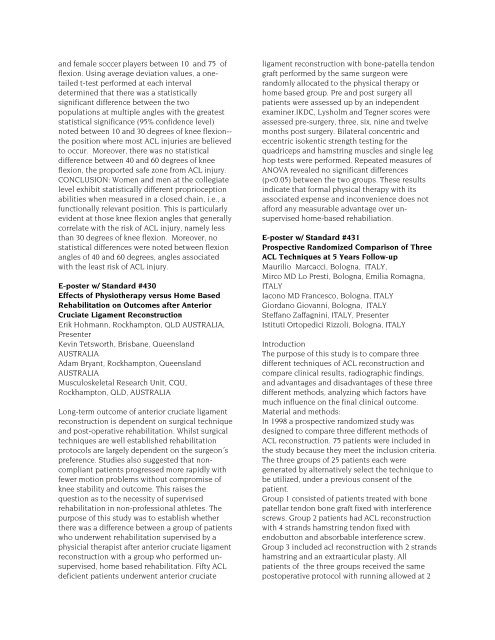POSTER ABSTRACTS - ISAKOS
POSTER ABSTRACTS - ISAKOS
POSTER ABSTRACTS - ISAKOS
Create successful ePaper yourself
Turn your PDF publications into a flip-book with our unique Google optimized e-Paper software.
and female soccer players between 10 and 75 of<br />
flexion. Using average deviation values, a onetailed<br />
t-test performed at each interval<br />
determined that there was a statistically<br />
significant difference between the two<br />
populations at multiple angles with the greatest<br />
statistical significance (95% confidence level)<br />
noted between 10 and 30 degrees of knee flexion--<br />
the position where most ACL injuries are believed<br />
to occur. Moreover, there was no statistical<br />
difference between 40 and 60 degrees of knee<br />
flexion, the proported safe zone from ACL injury.<br />
CONCLUSION: Women and men at the collegiate<br />
level exhibit statistically different proprioception<br />
abilities when measured in a closed chain, i.e., a<br />
functionally relevant position. This is particularly<br />
evident at those knee flexion angles that generally<br />
correlate with the risk of ACL injury, namely less<br />
than 30 degrees of knee flexion. Moreover, no<br />
statistical differences were noted between flexion<br />
angles of 40 and 60 degrees, angles associated<br />
with the least risk of ACL injury.<br />
E-poster w/ Standard #430<br />
Effects of Physiotherapy versus Home Based<br />
Rehabilitation on Outcomes after Anterior<br />
Cruciate Ligament Reconstruction<br />
Erik Hohmann, Rockhampton, QLD AUSTRALIA,<br />
Presenter<br />
Kevin Tetsworth, Brisbane, Queensland<br />
AUSTRALIA<br />
Adam Bryant, Rockhampton, Queensland<br />
AUSTRALIA<br />
Musculoskeletal Research Unit, CQU,<br />
Rockhampton, QLD, AUSTRALIA<br />
Long-term outcome of anterior cruciate ligament<br />
reconstruction is dependent on surgical technique<br />
and post-operative rehabilitation. Whilst surgical<br />
techniques are well established rehabilitation<br />
protocols are largely dependent on the surgeon´s<br />
preference. Studies also suggested that noncompliant<br />
patients progressed more rapidly with<br />
fewer motion problems without compromise of<br />
knee stability and outcome. This raises the<br />
question as to the necessity of supervised<br />
rehabilitation in non-professional athletes. The<br />
purpose of this study was to establish whether<br />
there was a difference between a group of patients<br />
who underwent rehabilitation supervised by a<br />
physicial therapist after anterior cruciate ligament<br />
reconstruction with a group who performed unsupervised,<br />
home based rehabilitation. Fifty ACL<br />
deficient patients underwent anterior cruciate<br />
ligament reconstruction with bone-patella tendon<br />
graft performed by the same surgeon were<br />
randomly allocated to the physical therapy or<br />
home based group. Pre and post surgery all<br />
patients were assessed up by an independent<br />
examiner.IKDC, Lysholm and Tegner scores were<br />
assessed pre-surgery, three, six, nine and twelve<br />
months post surgery. Bilateral concentric and<br />
eccentric isokentic strength testing for the<br />
quadriceps and hamstring muscles and single leg<br />
hop tests were performed. Repeated measures of<br />
ANOVA revealed no significant differences<br />
(p
















